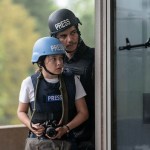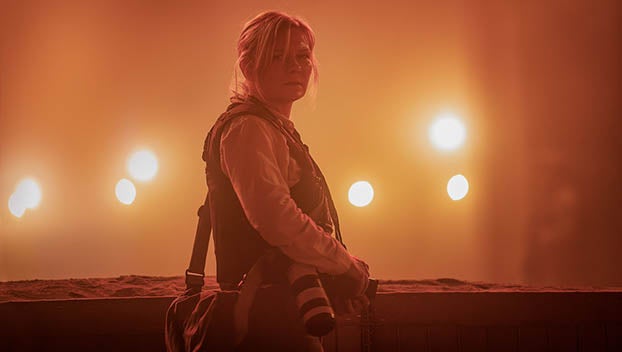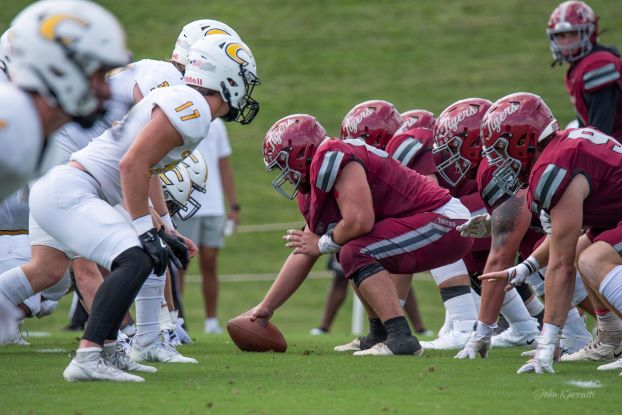Movie Review: Civil War
Published 12:00 pm Thursday, May 2, 2024


|
Getting your Trinity Audio player ready...
|
Even with a title like CIVIL WAR, writer/director Alex Garland’s latest blockbuster isn’t as political as you may think. Instead, it is a jarring semi-horror film that spotlights what could happen in the United States if differences in politics, opinion, demographics, etc. continue to create schisms that escalate into violence. But even more than that, the film is a love letter to photojournalism, particularly war photographers, highlighting the dangers they put themselves through to serve as a conduit between the ground truth and worldwide audiences… even when their work is largely ignored or not taken seriously.
The film drops us into a broken United States. The time is unclear, and so is the political landscape. What is apparent, however, is that the seemingly authoritarian President’s (Nick Offerman) government is at war against the “Western Front”, a California-Texas secessionist movement that broke into open conflict. And despite the President’s confident rhetoric, the Western Front forces are closing in on him. Veteran war photographer Lee (Kirsten Dunst), a reference to famed war photographer Lee Miller, is on the ground in New York City, taking pictures of what violence looks like at the local level. But for her and fellow photographer Joel (Wagner Moura), they want to be closer to the front lines; their goal is to get to Washington, DC to interview the President before the Western Front forces take over the capital (and presumably kill him).
But the journey is going to be a difficult one. They will have to traverse dangerous areas where their journalist credentials may make them more of a target. When burgeoning photographer/cub reporter Jesse (Cailee Spaeny) and Lee’s longtime mentor Sammy (Stephen McKinley Henderson) join the car, it only adds to the stress. Lee finds herself in a mentor position for Jesse; and while she may be hesitant to admit it, sees glimpses of her younger self through Jesse’s risk-taking tendencies and instinct for the right picture. On the way to the White House, the foursome cover various shoot-outs between unknown forces; sometimes the people fighting may not even know their enemy’s affiliations. And while the plan may be to leave Sammy and Jesse at the Western Front’s staging ground in Charlottesville, Virginia for their own safety… it may not be that easy.
Trending
Civil War is an ensemble film, but Dunst is the glue that holds everything together. The quiet moments of her character Lee reflecting on her past experiences in overseas conflict zones and the monumental devolvement she is seeing in her own backyard pack the biggest punch. Others may have played this stoic character as just that, a one-note, emotionless “tough female character”. But her performance is full of complexity, which is shown in the life experiences written across her face, in her eyes as she’s taking in her surroundings during a fire fight, and in the words of caution she offers to Jesse about being the next generation of war photographer.
The film’s relentless intensity never lets up or overstays its welcome. In some action movies, the constant explosions get to be a bit monotonous after awhile, but I was fully on the edge of my seat the entire time. It also helped that the brilliant sound design, elevated through the IMAX theater’s Dolby speakers, made it feel and sound like the bullets were really flying over my head. It created a visceral experience in the theater, making you feel like you are behind enemy lines along with the main characters.
I know there is criticism for the film’s unclear political landscape. Admittedly, it is never really understood why California and Texas (of all places) would come together as the Western Front to secede from the United States. It also quickly becomes apparent that in a wartime environment, the distinction between “bad guys” and “good guys” are muddled, but I think that is the whole point of the movie. Once a country devolves into localized violence, rule of law and community go out the window. In one key scene, an unseen sniper is shooting at Lee’s group and some bedded down militiamen. The militiamen are less concerned with whose “side” the sniper is on… because, well, the bigger issue is that he is shooting at them period.
To me, the film’s initial conceit of Texas and California joining together to secede from the United States is the flashing sign that this film exists in a fantastical world, not something that we can directly compare to today. And maybe the criticism of the film’s lacking political stance is more a reflection of our desire for films to always choose a side, when the bigger message is about differences and being so quick to choose sides is what may get us to this place.
I have been a fan of Garland’s since his directorial debut, EX MACHINA, which is one of my favorite movies of the last ten years, and I will always be seated for one of his films; CIVIL WAR is no exception. It is a provocative thrill ride that artfully uses its lack of a singular political focus to make a statement itself, imagining the ways in which societal fractures risk magnifying our personal and communal fragility.
My Review: B+







